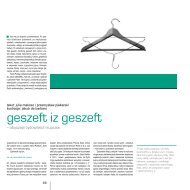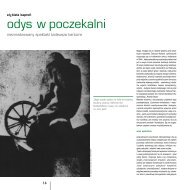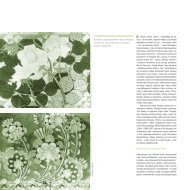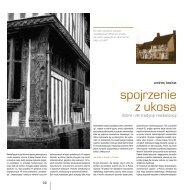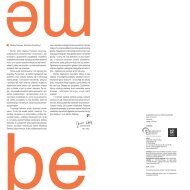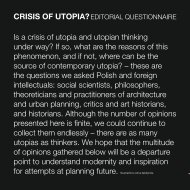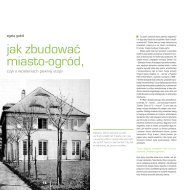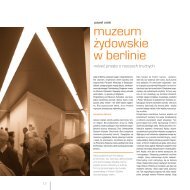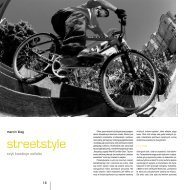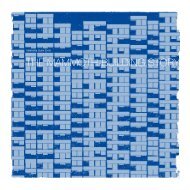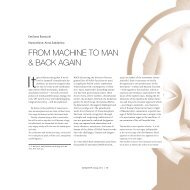ColleCtive luxury: - Autoportret
ColleCtive luxury: - Autoportret
ColleCtive luxury: - Autoportret
You also want an ePaper? Increase the reach of your titles
YUMPU automatically turns print PDFs into web optimized ePapers that Google loves.
to conceive the city in term of the useful,<br />
the needed, and the necessary rather than<br />
on the basis of the pleasant and passionate;<br />
and classify the needs aiming at satisfying<br />
them one after the other rather than<br />
focusing on the relationships between<br />
them – this was the main point in Lefebvre’s<br />
writings in urban sociology since the<br />
late 1950s. 25<br />
Thus, Fourier argued that the “unitary architecture”<br />
was the productive relationship<br />
of all senses. He wrote that: “the senses<br />
are thus reliable guides for social progress”<br />
and argued that one should think progress<br />
as a product of sensual pleasures which<br />
are composed, collective and integral and<br />
application to the mass of people. 26 For<br />
example – describing the common dinner<br />
rooms – Fourier shows how the sense of<br />
taste is composed (combined with spiritual<br />
pleasure of a conversation); collective<br />
(developed in the community of the tribe);<br />
and integral (embracing all branches and<br />
relations). The production of composed,<br />
collective and integral pleasure is thus the<br />
main aim of architecture. In other words,<br />
architecture is theorized as an art of association<br />
and putting together of senses,<br />
forms, bodies, and ideas.<br />
25 H. Lefebvre, “Les nouveaux ensembles urbains (un<br />
cas concret: Lacq–Mourenx et les problèmes urbains<br />
de la nouvelle classe ouvrière),” La Revue française<br />
de sociologie 1, no. 1–2 (1960): 186-201; Henri Lefebvre,<br />
“Utopie expérimentale: Pour un nouvel urbanisme,”<br />
Revue française de sociologie 2, no. 3 (1961): p. 191-198.<br />
26 Fourier, Des modifications, p. 38.<br />
This idea of architecture of association is<br />
the engine of Fourier’s vision of the phalanstery.<br />
The phalanstery was conceived as<br />
an assembly of dissimilar people; types and<br />
ages; and their novel combinations. As it<br />
was noticed by Roland Barthes, Fourier’s<br />
principle of combination was that of a formal<br />
and arbitrary correspondence; thus,<br />
an association is not a humanist principle<br />
(bringing together everyone with the same<br />
mania) but rather of contrast; neither was<br />
it a liberal principle which aims at “understanding”<br />
or “admitting” passions, but<br />
rather of their enjoyment. 27<br />
These comments make it clear that, when<br />
read in the early 1970s by Barthes and<br />
Lefebvre, both authors tracing the emergence<br />
of the post-war society of consumption,<br />
Fourier’s writings gained a new type<br />
of actuality. While for Benjamin the main<br />
metaphor of Fourier’s understanding of the<br />
society was the machine, for Barthes and<br />
Lefebvre this metaphor in Fourier’s texts<br />
was, clearly, information. And information<br />
was not only the paradigm for social development<br />
in the 1960s Western societies, but<br />
also, under the influence of structuralism,<br />
the dominant model for theorizing consumption.<br />
In the writings of Barthes and<br />
Jean Baudrillard, an object of consumption<br />
was theorized not as an answer to a need,<br />
but rather as a sign which obtains its meaning<br />
within a system of signs in a system of<br />
27 Barthes, Sade, Fourier, Loyola, p. 99.<br />
autoportret 2 [34] 2011 | 41<br />
differences. 28 This theorizing of consumption<br />
was strikingly similar to Fourier’s<br />
combinatorics of passions which bases on<br />
the differences between the people and activities<br />
involved. This was confirmed by the<br />
fact that the essential question of Fourier<br />
– and indeed one of the main reasons for<br />
his strategy of procrastination – was the<br />
problem essential to consumption, namely:<br />
how to prevent a boredom stemming from<br />
an excess of pleasures.<br />
This is why, introducing Actualité de Fourier,<br />
Lefebvre hesitates whether Fourier’s work<br />
is topical as a utopian socialist or a “dystopian”<br />
socialist; that is to say whether he<br />
is an author of a project of architecture<br />
of pleasure and spontaneity; or rather<br />
a prophet of the society of consumption<br />
and socialized worker. In this reading,<br />
Fourier’s work comes close to such projects<br />
as Archizoom’s No-Stop city, or Exodus by<br />
Rem Koolhaas and Elia Zenghelis: what<br />
decides, for Lefebvre, about the actuality in<br />
Fourier’s work in the cultural and political<br />
condition of the 1970s is a state of undecidability<br />
between utopia and dystopia.<br />
The text above is a revised version of an essay published originally<br />
in the "Hunch" magazine (No. 14, ed. Salomon Frausto, NAi<br />
Publishers / Berlage Institute, 2010).<br />
28 R. Barthes, The Fashion System (Berkeley: University<br />
of California Press, 1990 [1967]); J. Baudrillard, The<br />
System of Objects (London: Verso, 2005 [1968]).



